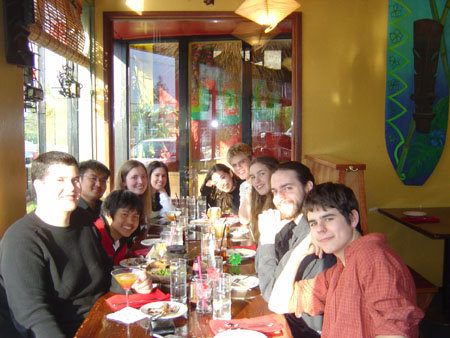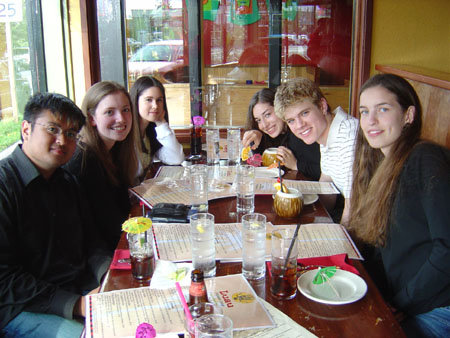Other chapters from the history of the Byrd Ensemble:
I. Byrdlings (2000-2004), II. Summer of Love (2004-2007), III. Digital media, money, and our first break (2008-2010)
I was a star Soprano in the Northwest Boychoir—at least it seemed that way. I got all the solos and sang gigs with the Seattle Symphony and Seattle Opera. I loved the stage. After my voice broke in 8th grade, I joined Vocalpoint Seattle, the high school arm of the NWBC, and sang pop songs with my fellow broken-voiced boychoir mates. It was not the same, but it was the easiest way to keep singing after our voices had changed. I graduated Nathan Hale High School in 1999 and decided to pursue a business degree at the University of Washington. My musical life appeared to be in the distant mirror.
Thomas Segen, a friend from the Northwest Boychoir, was taking music classes at Shoreline Community College. Thomas learned from his theory professor, Jeff Junkinsmith (fantastic composer!), that the Compline Choir at St. Mark's Cathedral was looking to add a few more singers. Thomas, Orrin Doyle (another friend from the Northwest Boychoir), and I auditioned and eventually joined the Compline Choir under the direction of Peter Hallock in 2000. I was 20 years old.
Compline Choir in 2001. Left to Right: Markdavin Obenza, Doug Fullington, Peter Hallock, Nathan Jensen, Richard Greene, Joel Matter, Vernon Nicodemus, Bill Turnipseed, Brent Olsen, Orrin Doyle.

Preparing music for the weekly Compline service polished up my musicianship skills. I advanced my sight-reading abilities and started to develop a sense of tuning. Peter Hallock's psalms were the quintessential vibe of Compline, but required a proficiency in reading intervals. I discovered that I had a decent alto (countertenor) voice and together with Doug Fullington, we ruled the top part. I learned so much from Doug—how to sing a line, intonation, tone, all about Renaissance music—he has been an incredible mentor and is the most influential person in my musical life.
Because we all were trained using solfege, reading Renaissance music was not too difficult. Within no time, we had our own group of young singers, some of which were still teenagers, singing through some of the most difficult repertoire in the oeuvre.
Orrin, Thomas, and I, made incredible strides as musicians and singers and were invited to join Seattle-based professional choral ensemble, The Tudor Choir, directed by Doug Fullington in 2001. Other than the Seattle Opera Chorus, The Tudor Choir may have been the first professional choral ensemble in the Seattle area (all singers were paid), and as a 20 year old, felt so honored to be invited to sing in a professional choral group. At that age, making money as a singer was my passion, it meant everything. I decided to end the pursuit of a business degree at the University of Washington and pursue music instead, much to my parents disappointment (they are not disappointed now!). Whatever financial support I had evaporated with my choice to follow music and so I cobbled together a small amount of money singing in the Tudor Choir and as a section leader for several church choirs. I had a jam-packed Sunday: Sunday AM at Eastshore Unitarian, Evensong at St. Thomas in Medina (under the direction of David White), and Compline.
Tudor Choir 2002: Linda Strandberg, Mark Powell, Gary Cannon, Christina Siemens, Chris Freeze, Eleanor Fye, Penni Ferraris, Matt, Doug Fullington, Jennifer Fanning, Manard Stewart, Linda Sabee, David Stutz, Collin, Markdavin Obenza

In 2001, we went to the Tallis Scholars Summer School course in Oakham, where the Tallis Scholars, directed by Peter Phillips, gave the opening concert. That concert forever changed me. I was floored by the sound they made with only 10 singers. The sound was bright, rich in overtones, and loud. When they got loud, it sounded like the gauge of their vocal chords expanded. A wall over overtones washed over us and Orrin and I giggled like schoolboys in pure awe. Some singers I remember in the group: Andrew Carwood, Patrick Craig, Francis Steele, Sally Dunkley... We were obsessed. We wanted that sound for our own.
Tallis Scholars Summer School, Oakham (2001)

Orrin, Thomas, and I started meeting outside Compline to sing through some Renaissance music on our own. We enlisted a few recent graduates from the Northwest Boychoir. Because we all were trained using solfege, reading Renaissance music was not too difficult. Within no time, we had our own group of young singers, some of which were still teenagers, singing through some of the most difficult repertoire in the oeuvre. Here's a clip of the earliest recording we made in 2004, recorded on a minidisc player at First Lutheran Church in West Seattle.
Robert Pearsall's Lay a garland
In 2003, Music Northwest, a West Seattle based presenting organization led by Jane Hardy (also mother of Northwest Boychoir fellow Anders Marshall), asked our informal group to present a concert at First Lutheran Church! This was our shot. Our performance was slated for January 2004 and we rehearsed twice a week for a full year in order to prepare for our debut. For this performance, we officially started our group as "The Renaissance Singers." I was the oldest at 23 and my brother Willimark the youngest at 15.
Left to Right: Anders Marshall, Orrin Doyle, Thomas Segen, Willimark Obenza, Andy Fischer-Price, Markdavin Obenza, Naomi Hummel, Liz Martin, Brittany Glant. Not pictured: Teresa Clark.

This group was committed. Everyone with the exception of Liz came through the Northwest Boychoir organization. At this point, I sang alto in the line. Orrin, Thomas, and I, as the most experienced singers, did what we could to pass on our skills to the others. Like myself, Anders and Orrin were also Soprano darlings from the Northwest Boychoir, so their reading was solid, Willi was my little brother who had a remarkably bright and plain baritone, Naomi was the alto belter, Andy had a very beautiful resonant Bass sound, Liz was a solid Soprano from the Northwest Girlchoir. (I remember when she first came to rehearsal. I told her there was a fee to be involved in the performance. The "fee" I meant was money that we would pay her for her time. Liz misunderstood and brought a check for that amount thinking it was a registration fee to be in the group. How sweet!), and Brittany had incredibly easy high notes. Teresa Clark (not pictured) was also a Vocalpoint alum. Unlike most of the singers in the Vocalpoint, her voice was already suited for choral singing, especially early music. She had a consistent bright and pingy tone through a part of the range where most singers had to negotiate an obvious break between chest and head voice. Teresa was true mean.
About 150 of our friends and family came to our first performance. We performed a selection of unaccompanied music from Machaut to Rutter. The first half was way too long and the second half was hilariously too short—I think only 18 minutes. We obviously had a lot to learn about programming. But what this performance ultimately did was solidify our commitment to the sound we were trying to create, and at such young an age, anything felt possible. We understood the talent required and we had the ears. All we needed to do was put in the effort and our young group could be something—right? At the time, the local early music scene was new, but fueled by very smart historians, academics, enthusiasts—we were the imposters. But maybe our young group could make a contribution to this field and send a message to general choral lovers that they can do it too, and that there is beauty in this music worth exploring.
Post-inaugural concert dinner!
Picture 1: Left to Right: Orrin Doyle, Willimark Obenza, Markdavin Obenza, Teresa Clark, Brittany Glant, Naomi Hummel, Andy Fischer-Price, Liz
Other chapters from the history of the Byrd Ensemble:




Comments